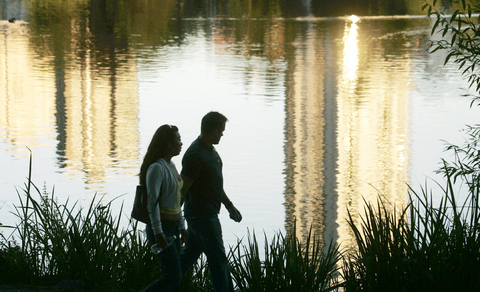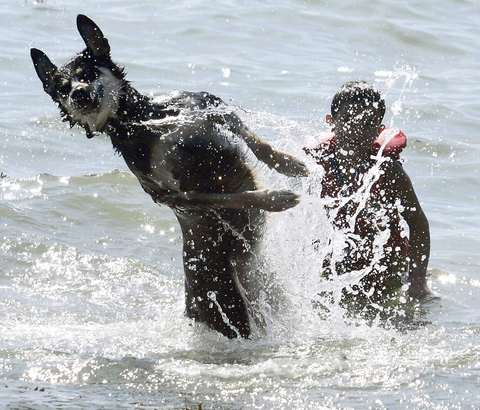It's the Canadian conundrum. Most visitors want to see a grizzly bear and get a handle on the scenery. Unfortunately, this is a vast place -- the second largest country in the world -- the range of scenery is enormous, and there are at most only 66,000 grizzlies scattered across the whole of North America.
However, last year Rocky Mountaineer Railtours teamed up with Knight Inlet lodge at Glendale Cove to offer a package combining a close grizzly encounter with a train journey from Vancouver to Calgary through some of the country's most varied scenery.
Knight Inlet lodge is a floating wooden platform moored just off a pine-covered hillside, an exhilarating 40-minute seaplane ride from Vancouver Island. A three-night stay is made special by great staff, excellent food, comfortable accommodation, a full program of activities and an odds-on certainty of meeting the odd grizzly or three. Banff national park, in the neighboring province of Alberta, can claim no more than 70 grizzlies in its whole 3,218km2, but Glendale Cove is swarming with them, with 43 in just 11km2.

PHOTOS: AGENCIES
And there are black bears, cougars, seals, orcas and eagles to keep them company.
Minutes after checking in, Jill, our guide, was taking us on our first estuary tour, the skiff gliding slowly across the flat water.
Near the lodge, wooden posts rose up out of the water, the skeletal remains of a salmon cannery from the 1920s. When logging was big here, there used to be a school, a church and around 1,500 people.

Now the 11km2 around the lodge is protected and hunting forbidden, and there are plans to extend this to 64km2. Sadly, the bears roam a lot further. Numbers in British Columbia are officially put at 11,000 to 13,000, although biologists believe this is optimistic, while hunters continue to "harvest" their trophies.
We soon found Ursus arctos horribilis, the world's largest land carnivore after the polar bear. This one was a sub-adult grizzly wandering along the shoreline, flipping large gray rocks as though they were pebbles, to reach the molluscs beneath. Through my binoculars, I could see the expression in his eyes as he tried to suss us out. "We don't allow camera flashes, we look for signs of stress when we approach the bears and leave if they are stressed," said Jill. "This means we can spend longer near them."
Early-morning kayaking was a silent way of seeing bears in the sedge. When they emerge from hibernation in the spring, they feed on this vivid green grass at the mouth of the estuary where a river winds out of the forest. In the autumn, you can watch the bears catching salmon here. We paddled quietly up the river, two woodpeckers tapping away in the trees deep in the mist.

For the tracking tour, we rode in an old yellow schoolbus down a disused logging road on the opposite shore. Tim, the guide, found bear prints, scratch marks on trees and old salmon skeletons on a carpet of pine needles above the river. Stepping out of the bus felt like walking into Jurassic Park without the luxury of being able to shout, "Cut!"
The inlet tour in a motorboat took us north up the wide fjord, pine trees growing all the way down to the deep water, snow-capped peaks rising above green mountains. Around 250 Pacific white-sided dolphins appear here to hunt the herring. We were splashed by five of them bow-surfing, close enough to touch.
Then, after surviving wilderness hazards we were suddenly back in a bustling Vancouver, the guard yelling a theatrical, "All aboard!" as we joined the Rocky Mountaineer. There is a choice of classes: Silver Leaf is a normal train coach, but Gold Leaf has a restaurant car with a glass-roofed observation car.
The railway across Canada was completed in 1885, after years of tunnelling, dynamiting and accidents -- it is estimated that a Chinese worker died for every kilometer of track. Somehow, the first train crossed the entire country and arrived only a minute late.
The first day covers 459km from Vancouver to Kamloops, leaving the skyscrapers of Vancouver via the huge Fraser river swing bridge for the Okanagan valley, the farmlands of British Columbia.
We followed the annual migratory salmon route along the Fraser. According to the onboard commentary by our guides -- both called Lisa -- every town has a story, although some have better stories than others. Hope, at the meeting of the Fraser and Coquihalla rivers, was so named because it was hoped that the fur hunters of the Hudson's Bay Company would have easier access to the interior here. It was also where Sylvester Stallone's First Blood was shot.
No exaggeration was needed concerning the cabaret about the 19th century train robber Billy Miner in Kamloops, a laid-back town of 87,000 spread over a valley where we stopped for the night.
On the train to Calgary, we passed the spot where Billy and his gang pulled off their last robbery, netting an impressive US$15 and some liver pills. Apparently his problem was that he was too polite.
Shuswap Lake was bordered with osprey nests on telegraph poles and luxury houseboats where you can get pizza delivered by boat. In Glacier national park, the broad pebbled Bow river widened and turned a cold green, dead pine trees lying underwater like ghosts.
As the air freshened it rained, then snowed, as the Rocky mountains appeared at last, snow defining the crevices, and cloud enveloping the peaks of Mount Temple and Castle Mountain. East of Banff, the 3,048m Three Sisters were a fitting climax to the Rockies. Then they faded into the sunset as we moved into the dry grass plains. I spotted a lone coyote in the thinning trees at the edge of the prairie, a suitable farewell from the wild interior where the lights of Calgary don't reach.
TRAVEL BOX:
☆ LINKS: rockymountaineer.com; travelcanada.ca
☆ TLink Travel Service Co Ltd
Call: (02) 2562 9335
Email: ctlink@ms43.hinet.net
Fly By Cathay Pacific via Hong Kong to Vancouver:
1 way to NT$21,800
Round trip to NT$37,300
☆ Super Star Travel
Call: (02) 2727 6018
Email: superstaragent@hotmail.com
Fly by Phillippine Airlines via Manilla to Vancouver:
1 way to NT$25,500
Round trip to NT$29,500
☆ Enquiry numbers in British Columbia:
http://www.mser.gov.bc.ca/prgs/enquiry_bc.htm
☆ Ferry schedules in British Columbia:
http://www.bcferries.bc.ca/schedules/
☆ Information about British Columbia Parks:
http://wlapwww.gov.bc.ca/bcparks/

In the March 9 edition of the Taipei Times a piece by Ninon Godefroy ran with the headine “The quiet, gentle rhythm of Taiwan.” It started with the line “Taiwan is a small, humble place. There is no Eiffel Tower, no pyramids — no singular attraction that draws the world’s attention.” I laughed out loud at that. This was out of no disrespect for the author or the piece, which made some interesting analogies and good points about how both Din Tai Fung’s and Taiwan Semiconductor Manufacturing Co’s (TSMC, 台積電) meticulous attention to detail and quality are not quite up to

April 21 to April 27 Hsieh Er’s (謝娥) political fortunes were rising fast after she got out of jail and joined the Chinese Nationalist Party (KMT) in December 1945. Not only did she hold key positions in various committees, she was elected the only woman on the Taipei City Council and headed to Nanjing in 1946 as the sole Taiwanese female representative to the National Constituent Assembly. With the support of first lady Soong May-ling (宋美齡), she started the Taipei Women’s Association and Taiwan Provincial Women’s Association, where she

It is one of the more remarkable facts of Taiwan history that it was never occupied or claimed by any of the numerous kingdoms of southern China — Han or otherwise — that lay just across the water from it. None of their brilliant ministers ever discovered that Taiwan was a “core interest” of the state whose annexation was “inevitable.” As Paul Kua notes in an excellent monograph laying out how the Portuguese gave Taiwan the name “Formosa,” the first Europeans to express an interest in occupying Taiwan were the Spanish. Tonio Andrade in his seminal work, How Taiwan Became Chinese,

Mongolian influencer Anudari Daarya looks effortlessly glamorous and carefree in her social media posts — but the classically trained pianist’s road to acceptance as a transgender artist has been anything but easy. She is one of a growing number of Mongolian LGBTQ youth challenging stereotypes and fighting for acceptance through media representation in the socially conservative country. LGBTQ Mongolians often hide their identities from their employers and colleagues for fear of discrimination, with a survey by the non-profit LGBT Centre Mongolia showing that only 20 percent of people felt comfortable coming out at work. Daarya, 25, said she has faced discrimination since she